We took a break for a few days last week to stay outside Agen and visit the area nearby, between the rivers Garonne and Lot. Lac Bajamont, is not well known but was nearby so we decided to take a look. At first site it reminded me of some of the small lochs you see in Scotland, it even had a fisherman on the bank.
There were plenty of thistles around but you would not see a Hummingbird Hawk moth (Macroglossum stellatarum) in Scotland!
The lake was bordered by wild flowers like these purple loosestrife (Lythrum salicaria) although it is not a natural lake but more a dam of 22 hectares that has been created by the nearby local councils to control local flooding and regulate the flow of the river. The lake is under the protection of the Fishing Federation of the Lot and Garonne and is used for course fishing.

As we walked around the lake we were impressed by the variety and abundance of wildflowers.

Of course, where there are flowers there is lots to see. I think that someone must have had hives as honey bees were very much in evidence on the flowers.

There were lots of Meadow Browns and I spotted the very similar Gatekeeper as well.
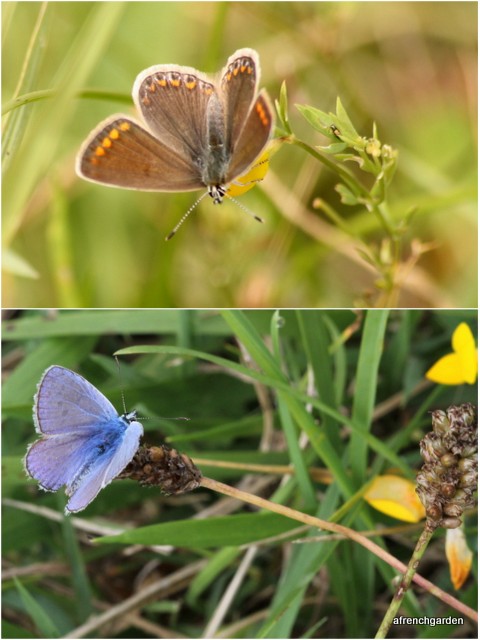
The bright blue of the male butterflies seems so unreal.

Sometimes you need to get closer to feel the full impact of the colours and patterns, like the eyes of this Spotted Fritillary.
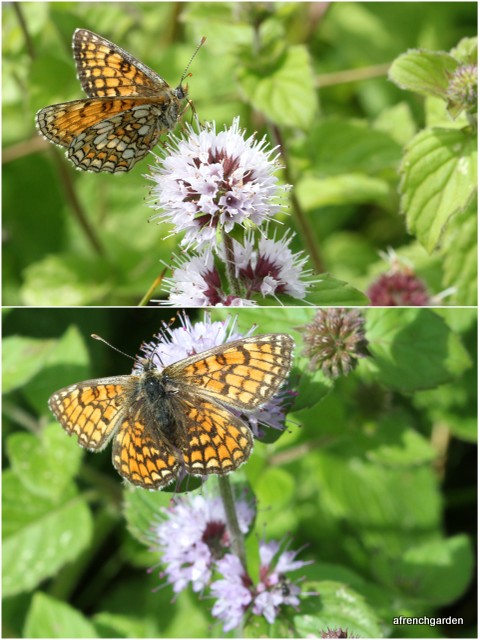
Perhaps it is a good point to mention that I have done my best to identify all the creatures that we managed to take decent photographs of, because I would like to share our walk, but I am not an expert and I apologise in advance if I I have made any errors!
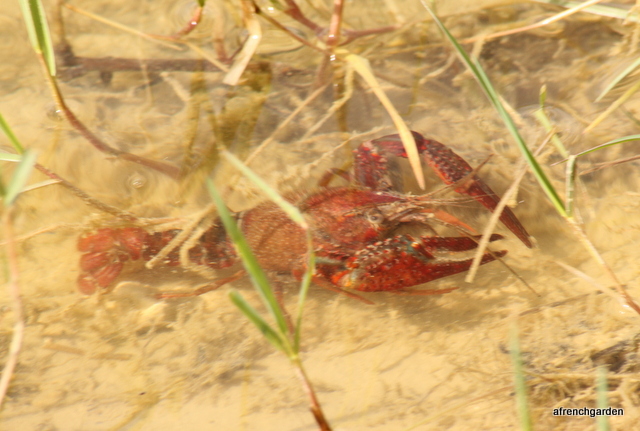
The waters of the lake are so clear at the edges that Kourosh was able to take this picture of the Crayfish under the water. This is an invasive variety and not a natural European species. I must give Kourosh the credit for many of the photographs in this blog as I kept on my Macro lens as there were so many small creatures attracting my attention.
The lake is kept only as a nature reserve. No swimming or motor boats are allowed and fishing is with a permit only. This allows joggers and picnickers a site to enjoy the outdoors and its peace.
Most of the flowers were similar to the ones we see in our area but I had never seen Hoary Plantain (Plantago media) before.
The more common plantain flower is very plain but this plantain has lovely lilac/pink flowers that the bees and butterflies find very attractive.

There was lots of Knapweed around. This is really a plant to attract all sorts of pollinators and one I am going to try to increase in my garden.

There were lots of blue chicory flowers, this one was being attacked by a snail much to the disgust of the little bee.

Of course, being beside the water there were plenty of damselflies and dragonflies around. Just so much to see.
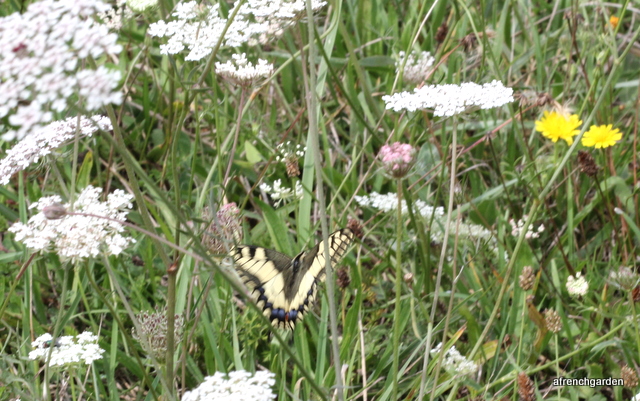
I at last saw my first Swallowtail of this summer. Not a great photo as it is taken with my Macro lens after a close chase. It is a big butterfly but it can shift!

This one was sunning itself and easier to capture. It had attracted my attention as it was purple! The colouration changed with the angle of the light that was falling on the wing scales. You can just see the slight colouration in the photograph but it does really look purple in certain lights, in others it looks a much less remarkable brown. I was very lucky to see it on several counts. Firstly the female does not have the purple reflection and secondly they often spend the day on the crowns of trees. The eggs are laid on Poplars and Willows and we have plenty of those near us but this is the first time I have seen it.
Unfortunately, I’ve had no luck identifying this. I would guess at a moth, but it has such a strange wing shape.
I’ll close with a picture of some vetch. We took so many photographs on our short walk round the lake that it’s been hard to condense them to give an idea of the place. Our lasting impression was of admiration for the brilliant solution to the areas previous flooding problem.

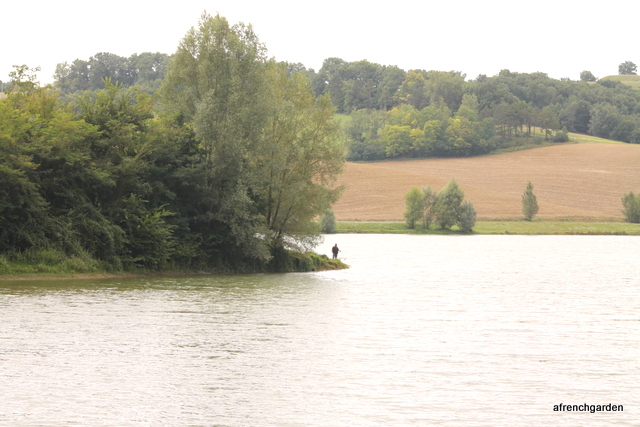
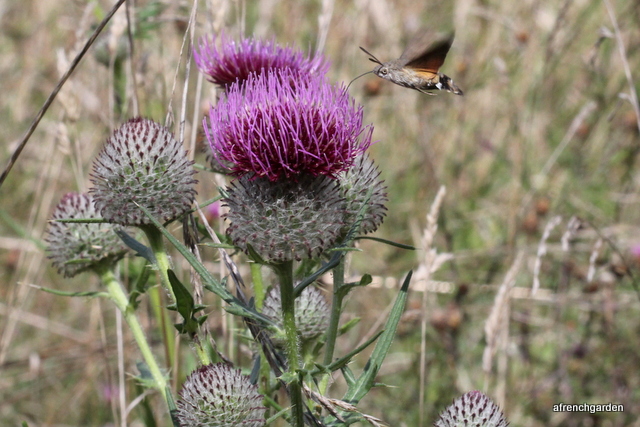

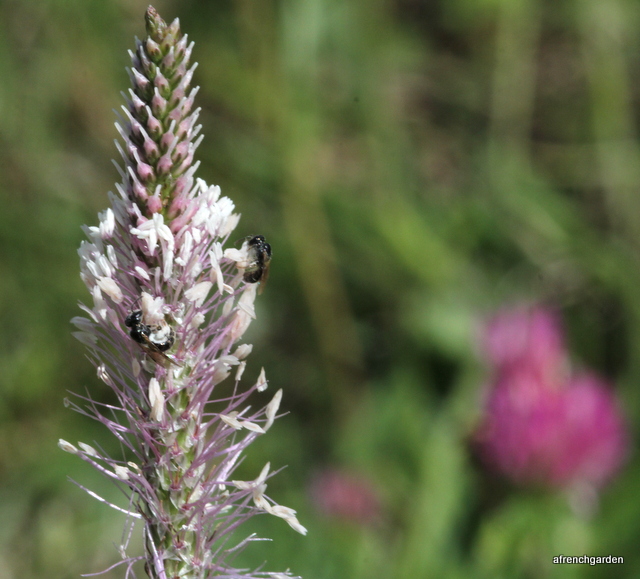
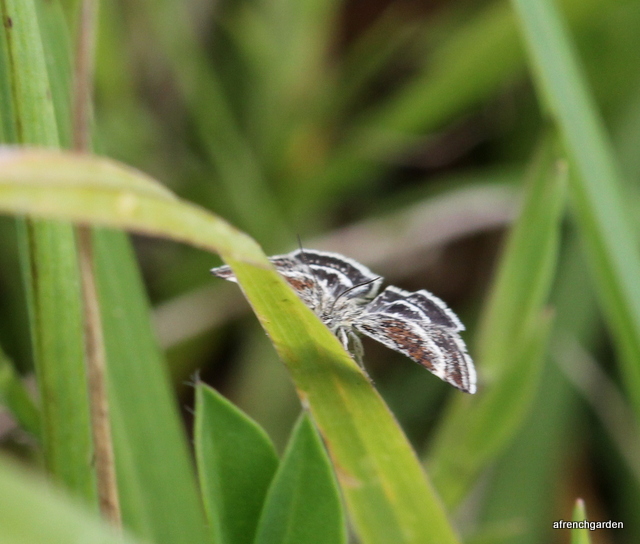

That is one heck of a bug safari. Lots of good stuff.
LikeLiked by 1 person
Thanks, it meant it was a very slow walk – I kept on getting distracted! Amelia
LikeLike
It is the third picture that says “lochan” to me….
provided I cover up the opposite bank.
The near bank is perfect!!
The first says “loch”…. especially with the fisherman!
The Emperor is a Lesser Purple Emperor [A. ilia]… four eye-spots.
Until we moved here, I didn’t know there was such a beastie!!
We get to see one or two a year… most years [none so far this!]…
but I’ll keep my eyes peeled.
That purple shimmer is wonderful!!
I recognise that moth…
but also don’t know its name….
but to me it is the “Turnstone” moth…
because the colours, and their positions…
always remind me of a Turnstone!!
Now I realise why the Victorian clergymen gave names to all the moths they collected!!
My favourite picture in this post is the chicory…
with the small banded snail and the bee!
A superb shot…
But, how I wish our neighbour’s etang was as nice as this Lac….
that is a reservoir for irrigation and kept devoid of plantlife…
both in the water and out of it….
strip mowed around the edge, even in winter…
and close grazed by sheepz at this time of the year…
the flies that it, or they, breed, tho’, do attract the bee-eaters at this time of year…
so we must give him some credit!!
—————————————
You asked “What are you feeding the Kingfisher that you have got it coming to the window?“….
no secret food at all…
the bief [millstream] that used to supply the water to power the forge…
passes ten feet from the back wall…
the river supplies the food…
the “Bill Oddie Kingfisher Trap” provides the perch over the water.
Zoom lens at 300mm [its max setting] allows me to “get the bird”…
and all the other users like the dragons and damsels….
that love to use it as well!
LikeLike
Thanks for that, Tim. I had it as that first and when I checked it again I made a mistake – I’m no good at spot the difference! I can imagine that millstream must attract a lot of visitors to the garden. I think Kingfishers are particularly beautiful because of their colour and speed.
Not being a birder I did not know you got bee-eaters in France. I’m not too sure if I would want them in my garden though. Amelia
LikeLike
Lovely to share your walk on this area unknown to me. I’ve been saying all summer that there has been a lack of butterflies and then on Thursday I saw 4 or 5 different species within 3 minutes.
LikeLike
I am seeing more here now, strange. Amelia
LikeLike
Such an abundance of wildlife and wildflowers. I must remember to look more carefully for the little creatures when I am out and about. Often I am so preoccupied with vistas that I forget to check what’s at my feet.
LikeLike
There are certain flowers like the Centaurea that will always have something on them if you take a moment to look at them in the sunshine. There will be different flowers that attract the bees and butterflies in New Zealand, though. Amelia
LikeLiked by 1 person
I just love that snail and bee on the chicory.
LikeLike
Glad you liked it, I notice you have taken your married name 🙂 Amelia
LikeLike
Beautiful!
LikeLike
I’m glad you liked it, Arthur, it was a lovely walk. Amelia
LikeLiked by 1 person
A beautiful Swallowtail AND a Purple Emperor. 🙂 That was certainly a lovely walk – thanks for sharing!
LikeLike
It was good to be able to see some of the natural areas and not all churches and bastides. Amelia
LikeLike
Yes, great solution! And fancy seeing thistles. Beautiful butterflies.
LikeLike
Actually, we get quite a lot of thistles around us too and I always keep my eyes on them as I often see bees and butterflies on them. It just goes to show how much can be done to improve something that is in fact practical and necessary and yet produce secondary benefits for leisure and pleasure. Amelia
LikeLike
Great that the thistles are such a magnet for wildlife, too!
LikeLike
This looks to be a wonderful place and so many species of Butterflies, you have taken some lovely photos too Amelia.
LikeLike
Thank you, I think the Fishing Association involved has done a great job in maintaining a pleasant place to fish for its members and improving other leisure activities. Amelia
LikeLike
These photos are excellent! I love the eyes on the spotted fritillary.
Coincidentally, I saw many meadow brown butterflies today too.
This was a great walk. I think I’d make it a regular event.
LikeLike
The Meadow Browns are all round us here at home, as well! How strange to think you are experiencing the same thing, yet so far away. Amelia
LikeLike
Hello Amelia,
WOW . What an array of stunning sights and brilliant photographs of them.
I can imagine you’d never have seen such variety ever in a decade of summers in Aberdeen! And some rarities I guess, amongst them?
BTW I’ve just read a brilliant book about Bumblebees which I think you would enjoy, if you haven’t found it already… (A Sting in the Tail by Dave Goulson – who amongst other things set up the Bumblebee Conservation Trust). I also discovered in this that he bought a run down holiday smallholding/property in Charente about 10 years ago, where he’s been restoring a wildflower/bee friendly meadow, and conducting some of his bee research there at a small village called Epenede? I can see now why, (apart from the weather!), he opted to choose a property in this part of France, where you’re blessed with such floral and insect diversity …if things are just left alone a little,
BW Julian
LikeLike
I loved that book and did a blog in June 2013, Reading Matters http://wp.me/p2cvii-Bw. I haven’t heard any further on how he is getting on with his wild flower meadow, it is a long term project but it will be interesting to read how he gets on. He must be somewhere a little to the north and two hours inland from us. I find bumblebees very difficult to identify. I also recommend the Humble Bee by FWL Sladen, he was born in 1876 so the style is much different but I loved that too. Amelia
LikeLike
Thanks for that, Sladen’s book got a recent plug at a talk locally on Bumblebees, as well as in DG’s book so I might try to find it. I’m hopeless with id-ing bumblebees as well, once I get past the early season queens. Did I mention that it turns out I went to the same school in Shropshire as Dave Goulson, though I passed through a bit before his time! So I was struck by his writings about his early interest in the Shropshire wildlife and natural history. Julian
LikeLike
I liked that bit too and it reminded me of “My family and other animals” by Durrell. I think love of nature starts early. Must have been a good school, to judge by the products!
LikeLike
I never read Durrell …perhaps now would be a good time. Actually Adams Grammar School seems to rank as one of the top 50 schools in the UK according to its current website, as ranked by exam results, which is quite surprising for a small town grammar school …it certainly didn’t seem like a special place when I was there…. pre league tables et al, though it was enjoyable enough!
LikeLike
Beautiful pictures! You’ve spared me the trouble of going for a walk myself which is nice since it’s miserably hot and humid here 😉 oh, alright. I may go out anyway.
LikeLike
We’ve had very few really hot days this year and I have not missed them but I’m amazed at the number of locals that feel they have not had a real summer. Amelia
LikeLike
great pictures – we have already booked next summer’s holiday – near Ceret, about 5 minutes walk from Spain – hoping for more insects than we go in Umbria this year 😉
LikeLike
We stopped overnight in Le Boulou on our way to Spain last spring but it is not an area I know, however, I am sure you will not be disappointed. I would also like to go to the Cote Vermeille which is not far away. Amelia
LikeLike
Very interesting pictures and comments, thank you. I remember getting a shock once while walking in rural Hampshire when I saw a crayfish in a shallow stream.
The sequel to Sting in the Tale comes out in about a week. It is called a Buzz in the Meadow and covers Goulson’s efforts to establish the flower meadow in France. Here is a link (sorry it’s Amazon): http://www.amazon.co.uk/A-Buzz-Meadow-Dave-Goulson/dp/0224101749
Philip
LikeLike
Thanks for that! It is just what I was wondering about, I must get it to read. Amelia
LikeLike
Just got it booked to be delivered in UK on its first day! I will be visiting my family then so it fitted in very well. Amelia
LikeLike
If you have time, it would be good to have your thoughts on the book when you have read it. Philip
LikeLike
I can imagine having to say something if it is as good as the last one.
LikeLike
What a lovely walk and I’m impressed you managed to get photos of so many butterflies. I see lots but rarely capture them on film.
LikeLike
I think butterflies can be very flighty. Sometimes they have no intention of staying long on a flower and they are impossible to catch on film. Other times they are set on feeding and stay much longer in place. You have got to find some that are hungry! Amelia
LikeLike
Lovely photos, Amelia. It’s been a great year for butterflies, until the cold wet weather arrived. I’ve never seen a purple emperor. If I had a butterfly ‘must get’ list (I don’t), it would be on it, near the top…
LikeLike
I hope you noticed I changed it to a lesser thanks to Tim. I checked it late at night and changed it to the wrong thing. It is an amazing butterfly, which my photograph did not do justice to as it really goes all purple in the correct light. Amelia
LikeLike